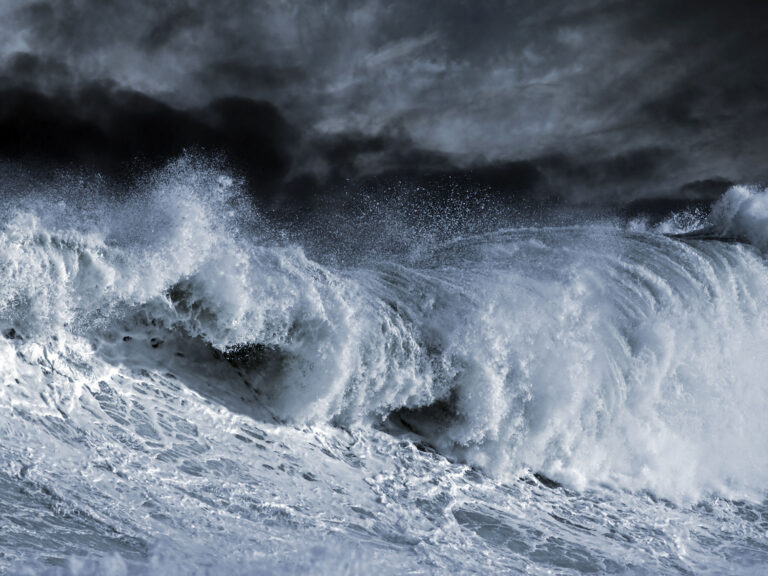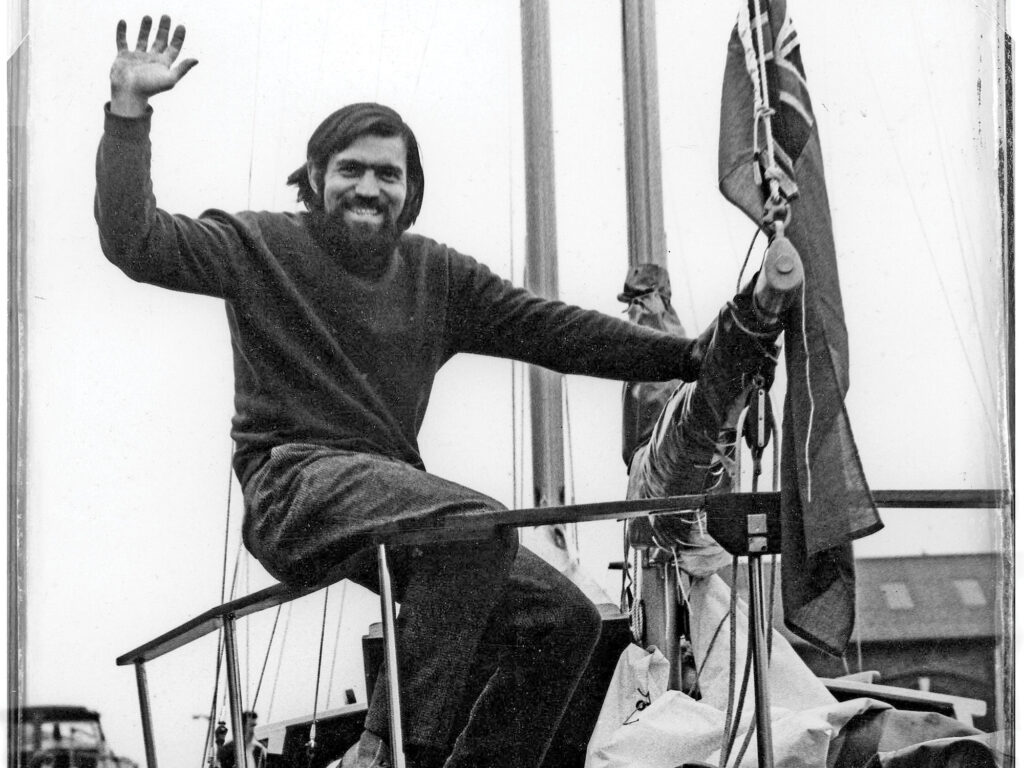
Every voyage starts with a dream. For me, it goes back a long while to when I was a little boy and wanted to become a sailor. That dream came true a quarter-century later. I was working in the Romanian language service of the BBC. My wife, Gwenda, and I had two children, Doina and Ivan, who were 6 and 4. Life seemed settled. The BBC Yacht Club had a 40-foot Lion-class sloop. I spent weekends sailing off England’s south coast and across the English Channel to France. It didn’t take me long to decide that sailing was definitely what I wanted to do.
The early 1970s were a time of great uncertainty in the world, and I felt that having a successful career could wait, whereas a world voyage with the family could not. Fortunately, Gwenda was a passionate traveler. To my surprise and relief, she fully supported the idea.
Our main concern was the children’s education. Gwenda completed a two-year evening course in education and taught for one year in a London school to gain experience. Meanwhile, I took courses in seamanship and navigation, and started looking for a boat. We could not afford even a used boat, so—with a loan secured against our small property—we bought a 36-foot bare fiberglass hull. All the rest of the work I would have to do myself.
In spring 1973, it was wheeled into a shed at London’s Royal Albert Dock. I looked over the side into the void and saw the magnitude of my undertaking. Many unfinished hulls, mostly ferrocement, were spread about the shed.
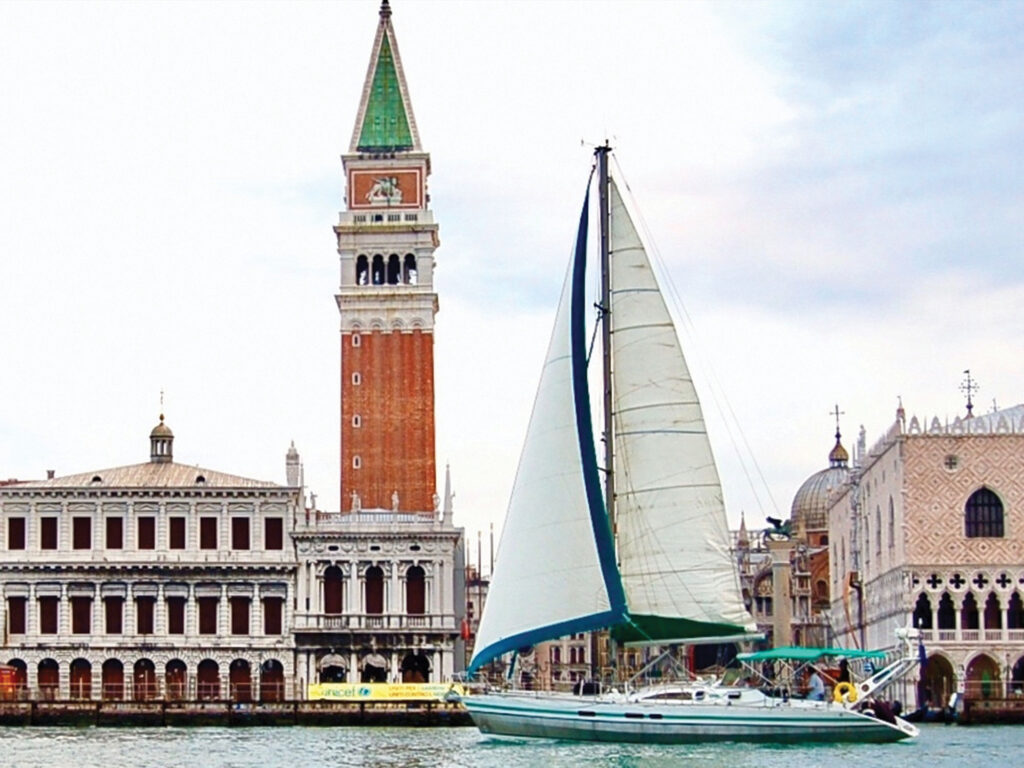
Still, it was a friendly atmosphere, and I could always get help or advice from someone who knew more than I did, which was most people. This was by far the greatest challenge I had ever faced, but I was determined. Using every spare hour and weekends, slowly, I saw Aventura start to take shape.
The First Aventura Launches
In July 1974, I launched the boat, partly finished, for a test sail in the English Channel. That maiden voyage showed all the mistakes I had made, but I could easily put them right. By the following spring, we were ready to leave. I went to resign my job but was able to continue my weekly shortwave program. Also called Aventura (“adventure” in Romanian), it was a mix of adventure stories and pop music, and was a great success among an audience living under a communist dictatorship. I was thrilled with the weekly income of about $60 because the boat had swallowed all our savings. The BBC World Service also let me send recordings during our trip about interesting subjects and local people.
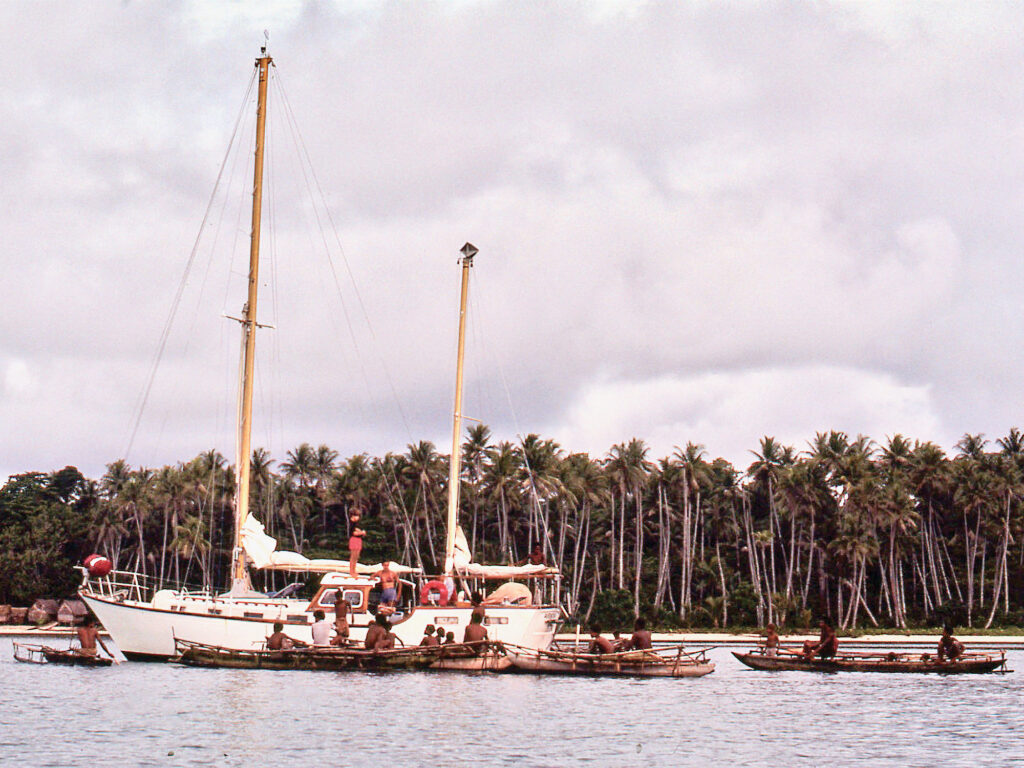
That was the beginning of my freelance career. It marked a significant turning point in my life. Looking out for original material became a permanent quest.
After a year in the Mediterranean getting used to this new life, we crossed the Atlantic, spent a year exploring the Caribbean and US East Coast, transited the Panama Canal, crisscrossed the South Pacific from Easter Island to Papua New Guinea and Tuvalu to Australia, cruised the entire Indonesian archipelago from Torres Strait to Singapore, and crossed our outward track via the Suez Canal.
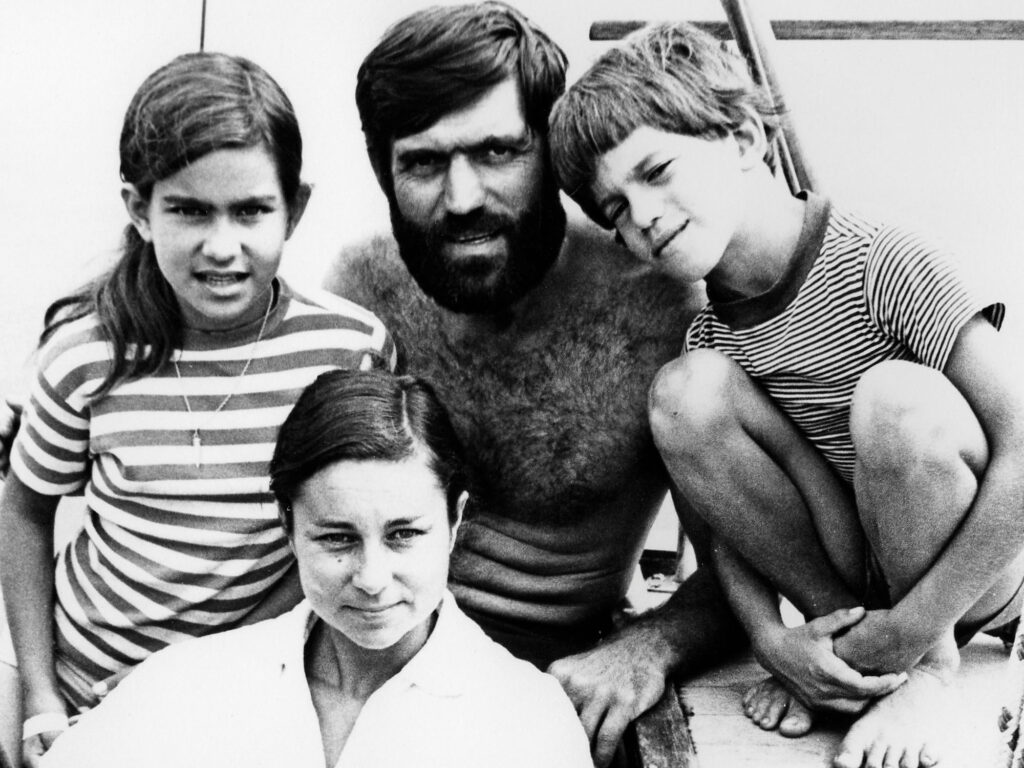
Our planned three-year voyage stretched into six. We would have spent even longer had Doina not reached the age of needing to resume her formal education. In 1981, we returned to London, the children returned to school, and we reintegrated into life on terra firma. We sold Aventura, and I rejoined the BBC.
We could not afford even a used boat, so—with a loan secured against our small property—we bought a 36-foot bare fiberglass hull. All the rest of the work I would have to do myself.
Throughout our 58,000-mile voyage, Aventura proved the best choice I could have made. Despite the boat’s modest length, it was a comfortable and safe home. The hull was strong, as I found out when we ran aground on a reef in the Turks and Caicos Islands. After the rising tide helped us off, there were only scratches.
Aventura II
When the time came to choose a successor for another world voyage, I had many ideas, in no small part because of surveys I had conducted among sailors we’d met. Nothing on the market came close, so I had a naval architect turn my ideas into a basic design. I contacted Bill Dixon, who was already known for his original approach to boat design. He produced the plans for the Aventura 40, a revolutionary design that included all the essential features I wanted.
During the three years we had spent in the South Pacific, I had heard of several boat losses due to navigational errors, groundings or collisions. I wanted the new Aventura to be as strong as possible, and in those days, that meant a steel hull. I also wanted good cockpit protection. An overall length of 40 feet is what I regarded as ideal.
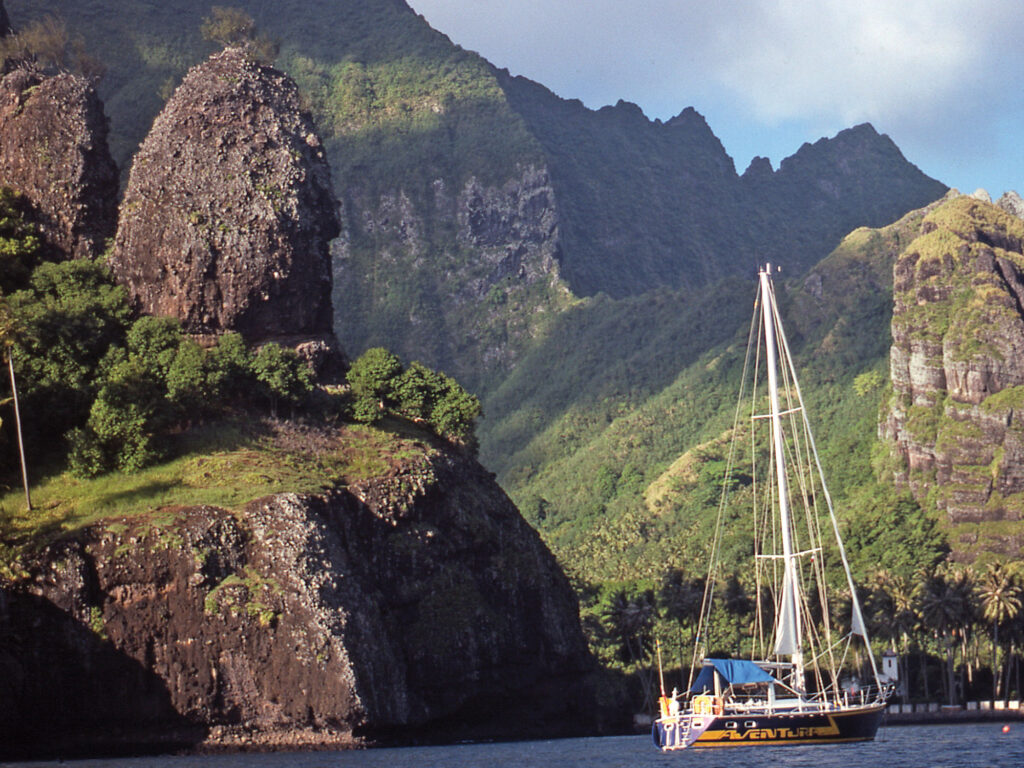
Since I believe that a shallow draft is an invaluable advantage when cruising, we included a retractable, hydraulically operated keel. It passed through a box that ended at deck level. Inspired by the Australian victory at the America’s Cup, I asked Dixon to add two large wings, which greatly improved the boat’s stability. The draft with the keel fully down was 5 feet, 10 inches. Twin rudders helped with the keel retracted; I believe this was something that had never been attempted on a cruising boat of that size before.
The most revolutionary feature was my idea of having two engines. Besides redundancy, the main advantage was that one engine, fitted with a powerful alternator, acted as a generating unit. Both of the 28 hp Perkins engines had Max-Prop folding propellers, which, combined with the two rudders, significantly increased maneuverability.
Our rig was a standard cutter with a Hood in-mast furling mainsail, which was popular in those days. An eye-catching feature was the hard dodger, which not only provided perfect cockpit protection, but it was also attractive.
The interior was quite unusual: The main cabin was in the stern, where a table and U-shaped settee were on a slightly raised platform with a good view to the outside. Two staterooms, separated by the keel box, occupied the center of the boat. The starboard one had a double berth, while the port one had bunks with high sides. A passageway through that stateroom led to the forepeak, which had submarine-type clamps and was a sacrificial collision zone. This was a service area with a full-size workbench, a dive compressor and gear, two inflatable dinghies, spare anchors, lines, and fenders.
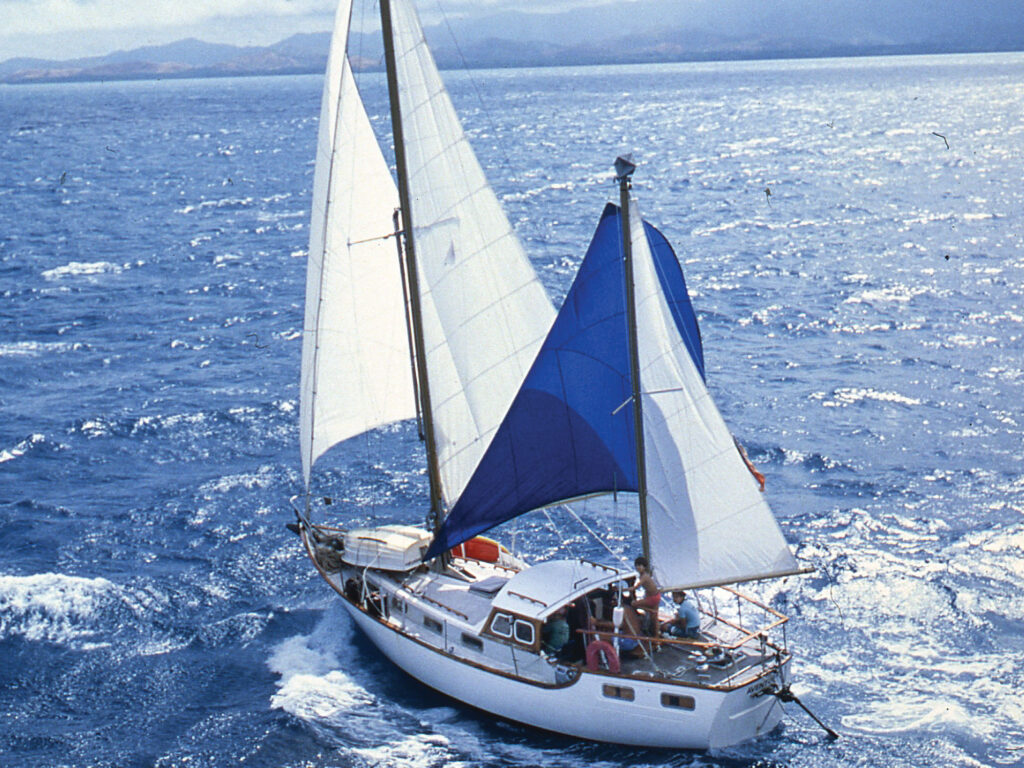
Sadly, this highly functional boat had one great disadvantage: It was designed to have a displacement of 12.5 tons but came in at 17 tons. The builder had fulfilled my request for a solid boat by creating a mini battle cruiser.
It was slow in light airs but stable and gentle in a strong breeze. Its versatility proved a great advantage in the first round-the-world rally. By the time I sold it in 1995, it had sailed over 40,000 miles.
Aventura III
The annual ARC and various other rallies, both trans-Atlantic and around the world, kept me busy in the late 1990s, but the temptation of a new world voyage became irresistible. The choice of the next Aventura was quite simple because I knew exactly what I wanted: a fast boat that was easy to sail shorthanded, and that would take me safely anywhere.
An obvious choice was the French-built aluminum OVNI range. All OVNIs shared a hard chine, flat bottom, integral centerboard and folding rudder. I set my eyes on the OVNI 43, which had a displacement of 9.5 tons and was known for good sailing performance.
After my previous experience, having a proven design produced by a reputable builder was a great attraction. And, because of the maintenance frustrations and costs of the previous Aventura’s steel hull, Aventura III had an unpainted hull. Besides its strength, aluminum’s greatest advantage is that it naturally forms a durable oxide layer on the exposed surface that prevents further oxidation.
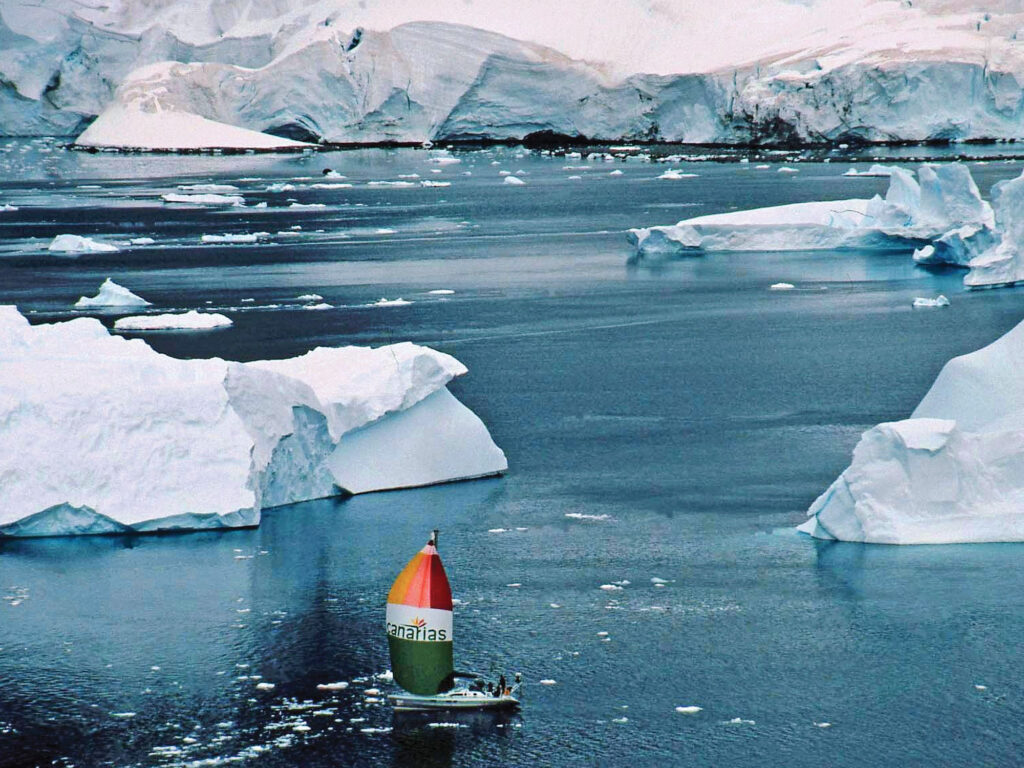
In 2010, when I sold Aventura III, having sailed 70,000 miles and 13 years, it took me fewer than a couple of days to bring that hull into pristine condition.
Aventura III is still close to my heart. A highlight was our voyage with Ivan from Antarctica to Alaska. That was followed by my third circumnavigation. At that point, I could say that I had sailed to all the places I wanted to see.
Aventura IV
There was, however, one location missing on my list: the Northwest Passage. Three years after having sold Aventura III, and fortunately still in good shape at 73, I felt that I should attempt to achieve this most challenging goal.
It also would be my last chance to create the ideal cruising boat. While each of my previous boats had original features, this boat could bring them all together and add new ones. I knew precisely what I wanted: a strong, fast, comfortable, functional and easily handled boat, for all seas and all seasons.
Still convinced that only aluminum could be the answer, I contacted French boatyard Garcia, at that time regarded as the best builders of aluminum boats in the world. I was fortunate to work with Stephan Constance, its CEO, and Olivier Racoupeau, one of France’s top naval architects. I told them that I wanted to keep the best features of my previous Aventura but add the nearly all-around visibility of a catamaran. As far as I knew, a deck salon had never been attempted on a yacht with an integral centerboard because the added height and weight might affect its stability. The designer solved this problem by settling for a low profile. I got a spacious salon with 270-degree visibility, and without compromising the stability or the looks of the new Exploration 45.
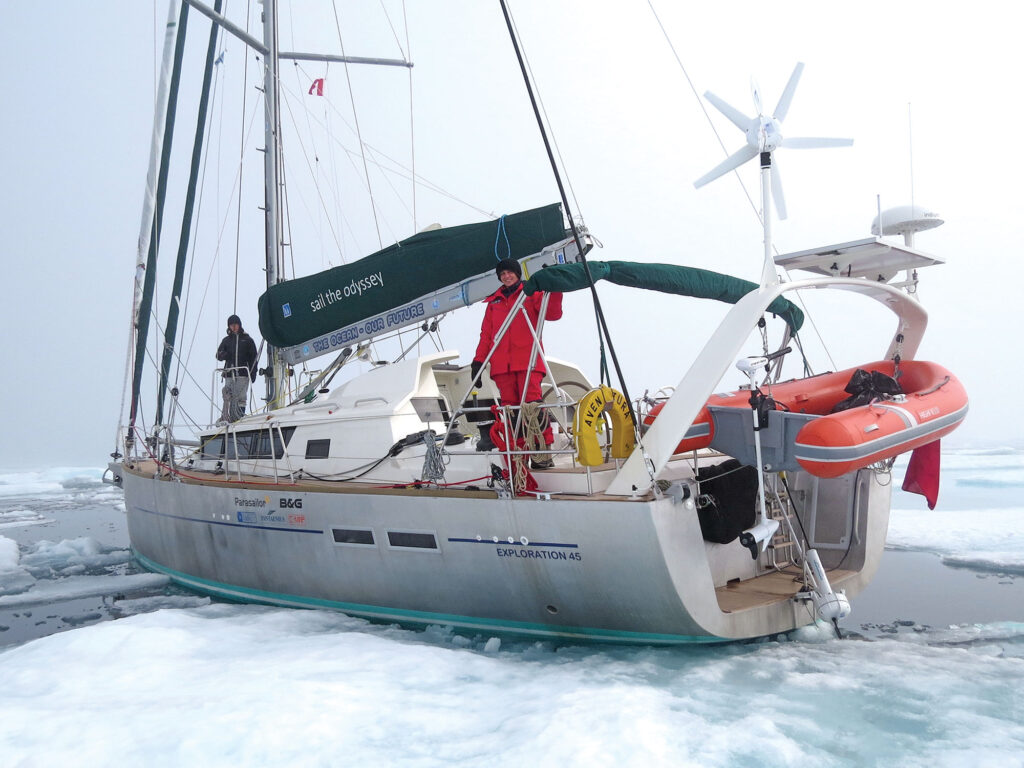
Safety, however, was the top priority. The hazards of sailing in high latitudes meant that the hull had to withstand collisions with ice. It should also have watertight collision bulkheads fore and aft. The two aluminum rudders, protected by skegs, should have a crumple area in the upper section of each rudder blade. If the rudder was pushed upward in a collision, the sacrificial section—made of light composite material—would absorb the shock and avoid any damage to the hull.
Because of my concern for the environment, I wanted the new Aventura to have as low a carbon footprint as possible. Unfortunately, none of the hybrid engines available at that time were suitable. I made up for that by using a combination of solar, wind and hydro generation.
On the advice of the designer, I agreed to a fractional rig with a full batten mainsail and Solent jib, a setup that he assured me made for a more efficient configuration. I also had a staysail for stronger winds. Occasionally they were used together, as on a cutter, usually with the Solent partially rolled up. The mast was also much better stayed than on my previous boat. Because of the swept-back spreaders, the lower shrouds did not obstruct the side deck.
Ice conditions in the Northwest Passage in 2014 stopped us from completing our attempt at making a transit from east to west. Rather than wait until the following summer, I attempted to do it from the opposite direction. We headed south from Greenland, transited the Panama Canal and, in summer 2015, passed through the Bering Strait and transited the Northwest Passage.
Aventura IV fulfilled all my expectations, and I doubt that I could have done the passage so safely and easily in any other boat. In a critical situation, we got caught in ice, and the boat behaved like a mini icebreaker. It was, however, just as much in its element when we cruised the Bahamas. A boat for all seas and all seasons, indeed. My quest for an ideal cruising boat had been achieved.
In 2017, with no plans for any more voyages, I decided that Aventura IV was not the kind of boat to spend the rest of its life sitting idly in some marina. I sold it to a sailor who was planning a similar Arctic voyage.
As for me, sadly, I had to admit that it was the end.
Or so I thought.
Aventura Zero
Historic anniversaries have always had a fascination for me, be it the 500th anniversary of the voyage of Christopher Columbus to the New World or of Vasco da Gama’s trip around the Cape of Good Hope. I celebrated by organizing rallies along their historic routes. The approaching anniversary in 2022 of the first round-the-world voyage was an opportunity I was not prepared to miss. I wanted to do something special for myself.
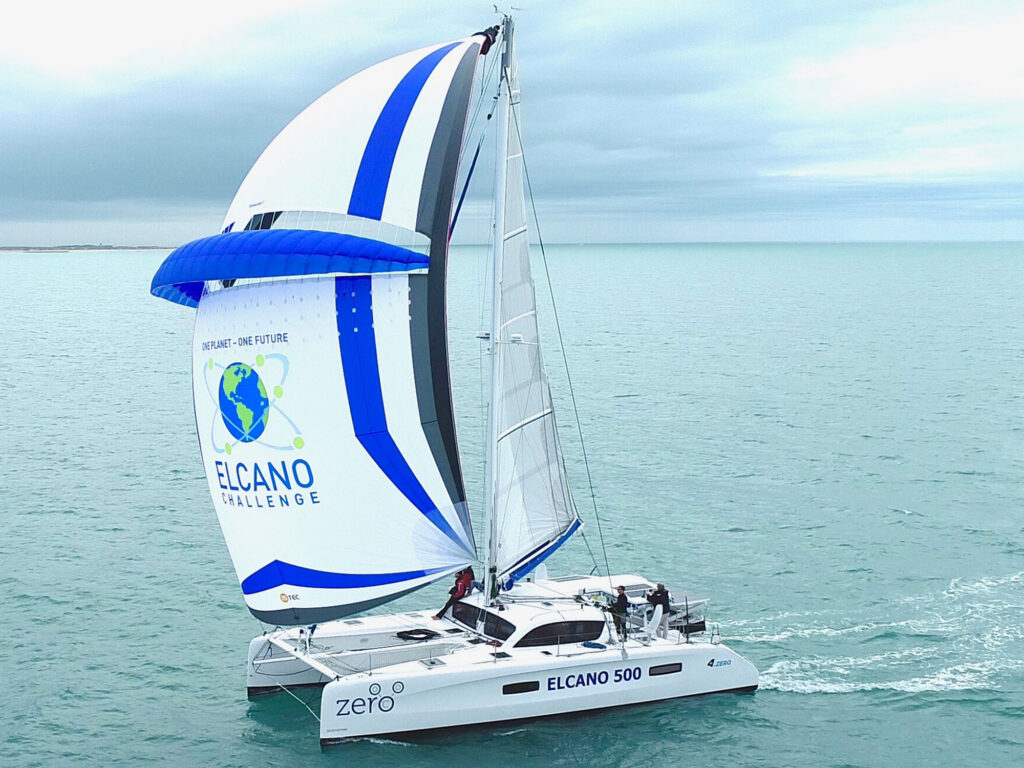
The first circumnavigation continues to be attributed to Portuguese navigator Ferdinand Magellan. In fact, the person who should be credited is Basque sailor Juan Sebastian Elcano. He sailed with Magellan from the start, took over the leadership of the expedition when Magellan was killed in the Philippines, and completed the voyage.
This is how the idea of my Elcano Challenge was born: to complete a circumnavigation along the same route by a fully electric boat. ElCaNo: Electricity (El), carbon (Ca), No.
The aim was to conceive a sailing boat using no fossil fuel for propulsion or electricity generation, and to rely exclusively on renewable sources of energy. The essential factor of electric propulsion on a sailing boat is the ability to generate electricity not just by passive means (solar and wind), but primarily by the boat’s movement. That means a potentially fast boat under sail, whether monohull or multihull. Ideally, such a boat should also have enough surface available to display several solar panels.
Because the time was too short to start such a project from scratch, I did it on an Outremer performance cruising catamaran. Xavier Desmarest, the CEO of Outremer, agreed to make all the necessary modifications to the yard’s standard Outremer 45.
The most important element was to generate electricity efficiently while underway. This desire led me to the Finnish company Oceanvolt, which had developed an ingenious system based on its ServoProp variable-pitch propeller. The software-controlled propeller could automatically adjust the pitch of the blades to provide an optimal level of regeneration or power output.
With a ServoProp capable of generating an estimated 500 watts at 6 knots and 800 watts at 8 knots, plus Aventura Zero’s solar panels with a capacity of 1300 watts, all my electricity needs would be covered. Under normal sailing conditions, it would be enough to charge the two propulsion battery banks of 28 kWh each, as well as a 2.4 kW service battery.
Outremer insisted that I install a backup diesel generator, but I refused. I hadn’t had a diesel generator on any of my previous boats. On my return from the Northwest Passage, Aventura IV’s engine failed, and we managed to sail more than 2,000 miles to the UK relying primarily on a Sail-Gen hydrogenerator that covered all our requirements: autopilot, instruments, communications, electric winches and toilets. We arrived at Falmouth Marina with fully charged batteries.
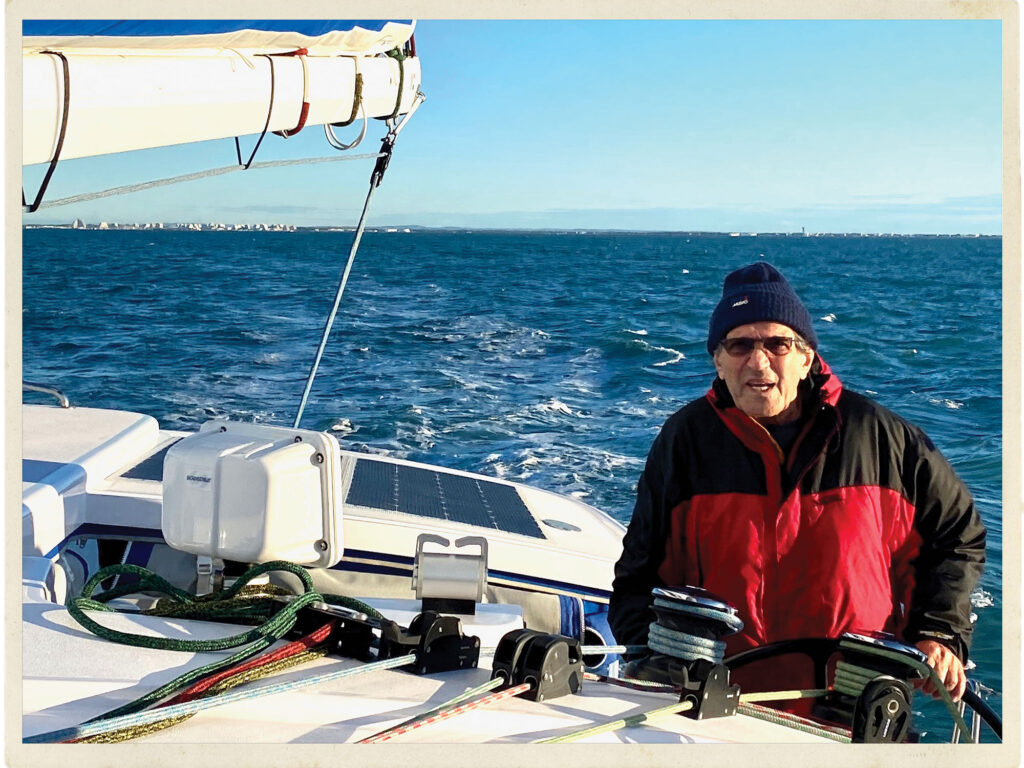
At my request, the sail plan of Aventura Zero had performance features, such as a self-tacking Solent jib and a rotating mast. The boat was launched in La Grande-Motte, in the South of France, in September 2020. Within a month, we were on our way to Seville and the formal start of this special voyage.
The night after our arrival, a thunderstorm of apocalyptic force broke over the city. Lightning struck the dock behind us and put the entire Oceanvolt electrical system out of action. It took two weeks to have it all replaced. By the time we got to Tenerife in the Canaries, COVID was raging, and several countries on our route were closed to visitors. My crew was reluctant to continue, and I agreed.
Still, the 3,600-mile North Atlantic maiden voyage had put Aventura Zero and its concept to a rigorous test, and we completed each of our offshore passages with zero carbon emissions. On the last leg, from Tenerife to France, I carefully monitored the systems, keeping a record of the rate of regeneration and overall electricity consumption. On that 10-day nonstop passage, all our electricity needs were covered by onboard regeneration. We left with the battery bank at 95 percent capacity and arrived with 20 percent, enough for an emergency.
Our 1,500-mile winter passage had been the perfect opportunity to put the concept to a proper test because we encountered a full range of weather conditions, including three gales with sustained winds higher than 40 knots. On that level, the test had been successful, albeit at the cost of a sustained effort to keep domestic consumption to a minimum. I was pleased that the concept itself had been proved right.
With no plans for any more voyages, I decided that Aventura IV was not the kind of boat to spend the rest of its life sitting idly in some marina. I sold it to a sailor who was planning a similar Arctic voyage.
One area in which I now believe that a compromise would be acceptable is to occasionally charge the batteries when stopping in a marina. After all, this is what electric cars are doing, and they still claim to abide by the zero-emissions principle. Doing the same with a sailing boat could be an acceptable solution for anyone planning to sail in places where access to charging points is easily available.
Conceivably, the future is electric.
Offshore cruising veteran Jimmy Cornell is the author of several books, including Sail the World With Me, a riveting recount of his voyages on the boats named in this story.






